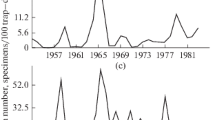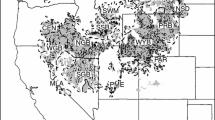Abstract—
Long-term data on fluctuations in the abundance of Laxmann’s shrew (Sorex caecutiens Laxmann) in the foothill taiga of the Northern Urals (Pechora-Ilych State Biosphere Reserve) have been evaluated using spectral analysis of time series. Periodic components in the population dynamics of the species have been revealed, including a statistically significant component that had a period of 3 years but was not highly regular. Analysis of factors accounting for variation in abundance parameters has shown that the population dynamics of S. caecutiens are influenced by both weather conditions and mechanisms of density-dependent regulation.


Similar content being viewed by others
REFERENCES
Krebs, C.J., Population Fluctuations in Rodents, Chicago: Univ. of Chicago Press, 2013.
Korpimäki, E., Norrdahl, K., Huitu, O., and Klemola, T., Predator-induced synchrony in population oscillations of coexisting small mammal species, Proc. R. Soc. Lond. B, 2005, vol. 272, no. 1559, pp. 193–202.
Zub, K., Jędrzejewska, B., Jędrzejewski, W., and Bartoń, K.A., Cyclic voles and shrews and non-cyclic mice in a marginal grassland within European temperate forest, Acta Theriol., 2012, vol. 57, no. 3, pp. 205–216.
Sheftel’, B.I., Cyclic population dynamics of small mammals and global climate change, in Mlekopitayushchie Severnoi Evrazii: zhizn' v severnykh shirotakh: Mat-ly mezhdun. nauch. konf. (Mammals of Northern Eurasia: Life at Northern Latitudes, Proc. Int. Sci. Conf.), Surgut: Surgut. Gos. Univ., 2014, pp. 19–20.
Kiselev, S.V. and Yamborko, A.V., Population dynamics of Laxmann’s shrew (Sorex caecutiens) and even-toothed shrew (Sorex isodon) in the Upper Kolyma basin, Zool. Zh., 2014, vol. 93, no. 9, pp. 1106–1116.
Erdakov, L.N., Panov, V.V., and Litvinov, Yu.N., The cyclicity in the dynamics of different populations of the common shrew, Russ. J. Ecol., 2019, vol. 50, no. 6, pp. 551–559.
Balakirev, A.E., Okulova, N.M., and Ivanter, E.V., On the analysis of factor influences on the long-term population dynamics of common shrew in the north and south of the range, Povolzh. Ekol. Zh., 2004, no. 2, pp. 111–122.
Popov, I.Y., Structure and dynamics of shrews on permanent plots in the European southern taiga, in Advances in the Biology of Shrews II (Special Publication of the International Society of Shrew Biologists), New York, 2005, vol. 1, pp. 291–301.
Tomášková, L., Bejček, V., Sedlaček, F., et al., Population biology of shrews (Sorex araneus and S. minutus) from a polluted area in central Europe, in Advances in the Biology of Shrews II (Special Publication of the International Society of Shrew Biologists), New York, 2005, vol. 1, pp. 189–197.
Bjørnstad, O.N. and Grenfell, B.T., Noisy clockwork: Time series analysis of population fluctuations in animals, Science, 2001, vol. 293, no. 5530, pp. 638–643.
Zhigalsky, O.A., Analysis of small mammal population dynamics, Zool. Zh., 2002, vol. 81, no. 9, pp. 1078–1106.
Dokuchaev, N.E., Ekologiya burozubok Severo-Vostochnoi Azii (The Ecology of Shrews in Northeastern Asia), Moscow: Nauka, 1990.
Vinogradov, V.V., Long-term dynamics and structure of shrews association (Soricidiae) in the mountain taiga of the Eastern Sayan, Contemp. Probl. Ecol., 2012, vol. 5, no. 1, pp. 97–103.
Kalinin, A.A., Demidova, T.B., Oleinichenko, V.Yu., and Shchipanov, N.A., Seasonal population dynamics of shrews (Insectivora, Soricidae), Zool. Zh., 2008, vol. 87, no. 2, pp. 218–225.
Ivanter, E.V., Ocherki populyatsionnoi ekologii melkikh mlekopitayushchikh na severnoi periferii areala (Essays on the Population Ecology of Small Mammals at the Northern Periphery of the Range), Moscow: KMK, 2018.
Henttonen, H., Haukisalmi, V., Kaikusalo, A., et al., Long-term population dynamics of the common shrew Sorex araneus in Finland, Ann. Zool. Fenn., 1989, vol. 26, no. 4, pp. 349–355.
Churchfield, S., Hollier, J., and Brown, V.K., Population dynamics and survivorship patterns in the common shrew Sorex araneus in southern England, Acta Theriol., 1995, vol. 40, no. 1, pp. 53–68.
Khodasheva, K.S. and Eliseeva, V.I., Zemleroiki v ekosistemakh Tsentral’noi lesostepi Russkoi ravniny (Shrews in Ecosystems of the Central Forest–Steppe Zone of the Russian Plain), Moscow: Nauka, 1992.
Ivanter, E.V., Korosov, A.V., and Yakimova, A.E., Ecological and statistical analysis of long-term changes in the abundance of small mammals at the northern limit of the range (northeastern Ladoga region), Russ. J. Ecol., 2015, vol. 46, no. 1, pp. 89–95.
Kupriyanova, I.F. and Sivkov, A.V., Small mammal communities in a nature reserve, in Struktura i dinamika prirodnykh komponentov Pinezhskogo zapovednika (severnaya taiga, ETR Arkhangel’skaya oblast’) (Structure and Dynamics of Natural Components of the Pinega Nature Reserve (Arkhangelsk Oblast, Northern Taiga, European Russia)), Arkhangelsk, 2000, pp. 168–178.
Ochocińska, D. and Taylor, J.R.E., Living at the physiological limits: Field and maximum metabolic rates of the common shrew (Sorex araneus), Physiol. Biochem. Zool., 2005, vol. 78, no. 5, pp. 808–818.
Okulova, N.M., Kupriyanova, I.F., and Sivkov, A.V., Population dynamics of small mammals in the Pinega Reserve: 1. Common shrew Sorex araneus, in Teriolo-gicheskie issledovaniya (Theriological Studies), no. 4, St. Petersburg, 2003, pp. 38–46.
Bobretsov, A.V., Populyatsionnaya ekologiya melkikh mlekopitayushchikh ravninnykh i gornykh landshaftov Severo-Vostoka evropeiskoi chasti Rossii (Population Ecology of Small Mammals in Plain and Mountain Landscapes of Northeastern European Russia), Moscow: KMK, 2016.
Hlôška, L., Chovancová, B., Chovancová, G., and Fleischer, P., Influence of climatic factors on the population dynamics of small mammals (Rodentia, Soricomorpha) on the sites affected by windthrow in the High Tatra Mts., Folia Oecol., 2016, vol. 43, no. 1, pp. 12–20.
Lima, M., Merritt, J.F., and Bozinovic, F., Numerical fluctuations in the northern short-tailed shrew: Evidence of non-linear feedback signatures on population dynamics and demography, J. Anim. Ecol., 2002, vol. 71, no. 2, pp. 159–172.
Ivanter, E.V. and Kurkhinen, Yu.P., Effect of anthropogenic transformation of forest ecosystem on populations of lesser and Laxmann’s shrews in eastern Fennoscandia, Printsipy Ekologii, 2014, no. 2, pp. 21–25.
Malyshev, Yu.S., Laxmann’s shrew, Sorex caecutiens Laxmann, 1758, in the Upper Angara Hollow: Abundance, landscape distribution, specific features of population structure and reproduction, Baikal. Zool. Zh., 2014, no. 2 (15), pp. 92–102.
Dokuchaev, N.E., Reproduction of shrews (Sorex) in Siberia, in Advances in the Biology of Shrews II (Special Publication of the International Society of Shrew Biologists), New York, 2005, vol. 1, pp. 419–431.
Shchipanov, N.A., Zima, J., and Churchfield, S., Introducing the common shrew, in Shrews, Chromosomes and Speciation (Cambridge Studies in Morphology and Molecules: New Paradigms in Evolutionary Biology), Searle, J., Polly, P., and Zima, J., Eds., Cambridge: Cambridge Univ. Press, 2019, pp. 19–67.
ACKNOWLEDGMENTS
The authors are grateful to Dr. K.V. Maklakov (Laboratory of Population Ecology and Modeling, Institute of Plant and Animal Ecology, Ural Branch, Russian Academy of Sciences) for his help in the statistical processing of time series and interpretation of the results.
Funding
This study was performed as part of the program “Dynamics of Animal Diversity on the Western Macroslope of the Urals and in the Adjacent Plain Part of Northeastern European Russia under Environmental Change” (project no. 18-4-4-30, registration no. AAAA-A17-117112850234-5) and supported by the Integrated Research Program of the Ural Branch, Russian Academy of Sciences (project no. 18-4-4-28).
Author information
Authors and Affiliations
Corresponding author
Ethics declarations
Statement on the welfare of animals. All applicable international, national, and/or institutional guidelines for the care and use of animals were followed.
Conflict of interest. The authors declare that they have no conflict of interest
Additional information
Translated by N. Gorgolyuk
Rights and permissions
About this article
Cite this article
Bobretsov, A.V., Lukyanova, L.E., Petrov, A.N. et al. Periodic Changes in the Abundance of Laxmann’s Shrew (Sorex caecutiens, Eulipotyphla) and Factors of Its Population Dynamics in the Foothill Taiga of the Northern Urals. Russ J Ecol 51, 282–287 (2020). https://doi.org/10.1134/S1067413620030030
Received:
Revised:
Accepted:
Published:
Issue Date:
DOI: https://doi.org/10.1134/S1067413620030030




